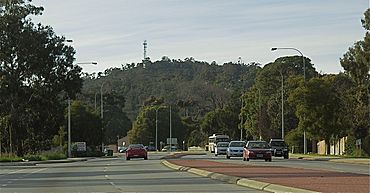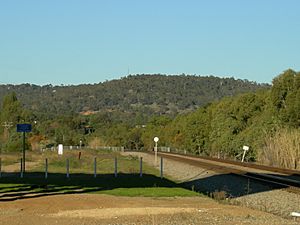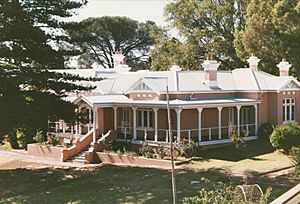Greenmount, Western Australia facts for kids
Greenmount is a place and a hill in Western Australia. It's located in the Shire of Mundaring, right on the edge of the Darling Scarp. This hill is super important for roads and railways, connecting the Swan Coastal Plain to the inland areas of Western Australia.
Quick facts for kids GreenmountPerth, Western Australia |
|||||||||||||||
|---|---|---|---|---|---|---|---|---|---|---|---|---|---|---|---|

Greenmount Hill from the Great Eastern Highway
|
|||||||||||||||
| Postcode(s) | 6056 | ||||||||||||||
| LGA(s) | Shire of Mundaring | ||||||||||||||
| State electorate(s) | Midland | ||||||||||||||
| Federal Division(s) | Pearce | ||||||||||||||
|
|||||||||||||||
Contents
Early History of Greenmount
Greenmount has a long history, especially since European settlers arrived.
First Explorations
Ensign Robert Dale was the first European to reach the top of Greenmount Hill. This happened on October 18, 1829. John Septimus Roe, another explorer, also used the name Green Mount for the York Road he traveled on.
Naming the Hill
In the early days of the Swan River Colony, the name "Greenmount" was used for two spots. One was on the York Road, called York Greenmount. The other was further north, called Toodyay Greenmount. People think these spots might have looked greener than other parts of the Darling Scarp.
Convicts and Quarries
In 1854, during the time when convicts were sent to Australia, Edward Du Cane oversaw building a convict depot on the hill. Later, in the 1870s, a government quarry was opened. This quarry dug up "bluestone" from the western side of the hill.
Important Transport Routes
Greenmount Hill is a key part of the transport network. It's the main way to go up or down the Darling Scarp.
Highways and Roads
Both the Old York Road and the Great Eastern Highway go over Greenmount Hill. Because the hill is so steep, it has often been a place where vehicles break down or have accidents. To make it safer, a special truck arrester bed was built at the bottom of the hill. This was put in place after a big accident in 1993. It helps stop large trucks if their brakes fail.
Railways Through Greenmount
The first Eastern Railway line used to run along the western and southern slopes of Greenmount. Later, a different railway route, the National Park deviation, also passed nearby. Even today, the current railway line is only a few kilometers west and north of the hill. Greenmount used to be a train stop until 1954. Passenger trains stopped running then, but freight trains continued until 1962.
Bus Services
Greenmount is served by several bus routes, connecting it to nearby towns and stations.
- Bus 323 goes from Midland Station to Swan View. It serves Innamincka Road and Wooloomooloo Road.
- Other bus routes use the Great Eastern Highway and Old York Road. These include:
* Bus 320 from Midland Station to Mundaring. * Bus 321 from Midland Station to Glen Forrest. * Bus 328 from Midland Station to Chidlow.
Quarries and Natural Beauty
Greenmount is home to several old quarries and is known for its natural look.
Old Quarries
There are three unused quarries on or near Greenmount Hill:
- Greenmount Quarry: This was known as the "Blue Stone Quarry" in the 1870s.
- Mountain Quarry: This quarry was active from the 1920s to the early 1960s. Today, it's a popular spot for abseiling (rappelling) and is often called "Boya Quarry."
- Hudman Road Quarry: This quarry has had many names, including "Mr O'Connor's quarry" and the "Government Quarry."
Why it's Still "Green"
The hill has kept its "green" name since the 1820s because it hasn't been built on much. It still looks natural and has attracted many artists and photographers. However, one part of the hill, called "Sugarloaf," was used for grazing animals for over 60 years. This area's green is from different plants, not the native jarrah forest that once covered the hill. Also, a power line cuts across the hill, which has caused some erosion and is considered an eyesore by some.
Towers and Access
Greenmount Hill once had aircraft warning lights, but these have been removed. Now, there's a police communication tower and a mobile telephone tower for Optus and Telstra. Road access through the Greenmount National Park is usually closed to prevent vandalism. You need special permission and keys from the Department of Environment and Conservation office in Mundaring to enter.
Undercliffe Estate
Undercliffe is a historic estate located in Greenmount. It is listed as a heritage site by the Western Australia Government.
Building Undercliffe House
The original land for Undercliffe was south of the York Road. It sits on a high spot, looking south over an old railway line. In 1897, Edmund Gilyard Lacey owned the land. His son-in-law, Percy Ford Robinson, bought it from him. In 1902, Robinson built Undercliffe House. He used bricks from his father-in-law's quarry. The house is a beautiful example of Australian Federation Queen Anne style. The front door has special stained glass that includes the name "Undercliffe" and Robinson's initials.
Changing Uses Over Time
During the Great Depression, Undercliffe House became a parish poorhouse (a place for poor people). In 1937, it was given to Rev John Bell, who turned it into a home for people recovering from illness. During World War II, it helped soldiers get better. After the war, it became a nursing home until 1981. Then, it was upgraded into a hospital, with new buildings for a nursing home, a maternity ward, and doctor's offices.
Gardens and Trees
In the early 1900s, the gardens at Undercliffe were very popular. Artists, train travelers, and drivers would visit them. Many of the original large gardens and trees are still there today. These include a huge Moreton Bay fig tree, a rare South American cyprus tree, a Norfolk pine, and several old date palms.
Greenmount's Importance
The Shire of Mundaring has listed Greenmount Hill as a very important landmark. It's recognized for its beauty, its social value, its history, and its scientific importance.
Images for kids



